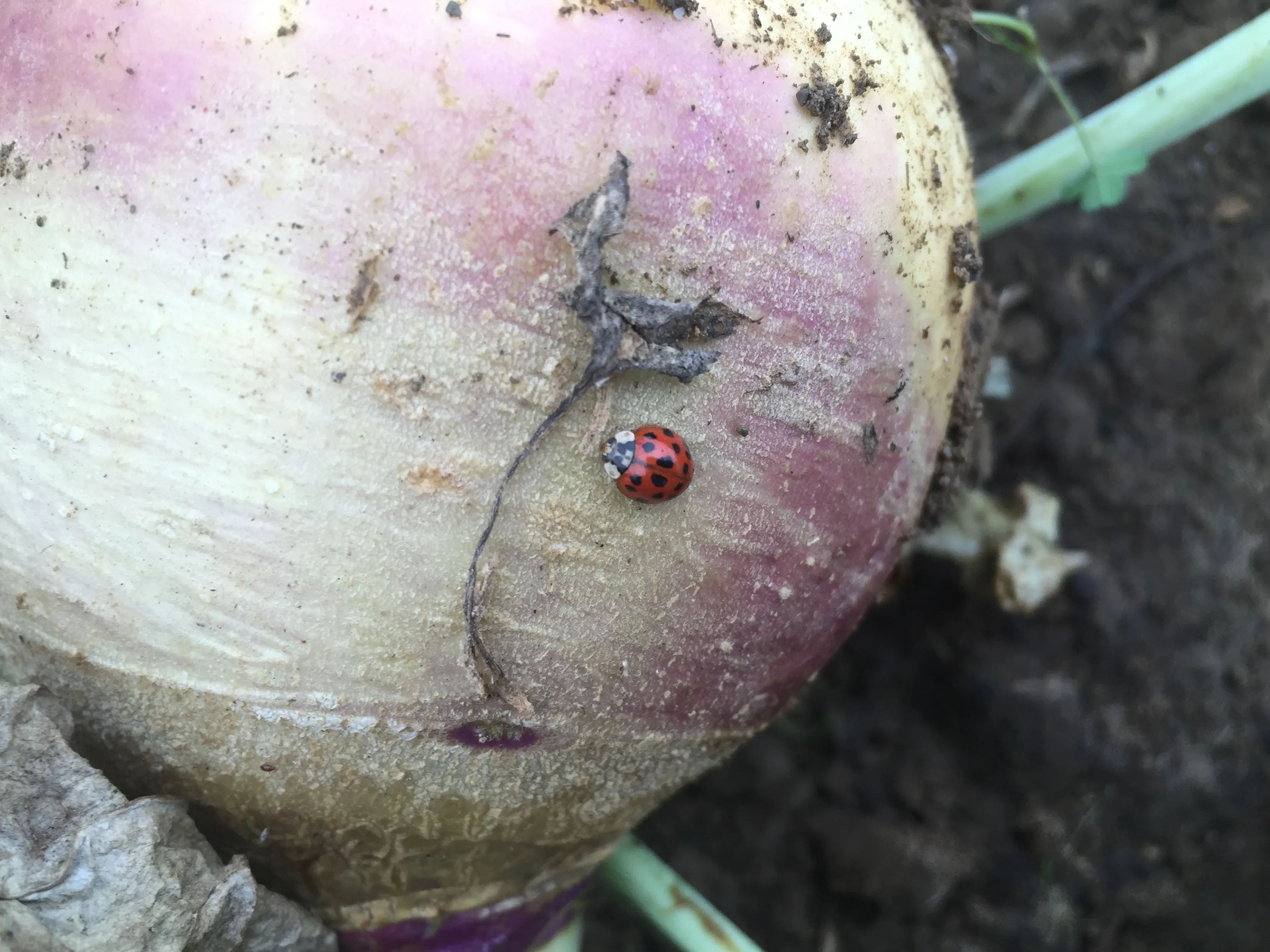Lady Beetles: The Hardest-Working Ladies On Your Farm
Photo Credit to Tamara Hanson, Windy River
Eco Farm
Farms are crawling with bugs - especially those practicing organic farming methods. Pests may be
the first bugs that come to mind, but many of these are beneficial insects, providing important
services from pollination to pest control.
The next few posts will take a closer look at beneficial insects that provide important pest
management services. Getting to know these beneficials includes knowing which pests they control,
understanding how to provide habitat, and being able to identify them at all life stages. (This last
bit is important, as I once worked with folks who were squishing lady beetle larvae, apparently
taking the “guilty until proven innocent” approach -- oops!)
Let’s start by taking a closer look at one of the most familiar and classic of all beneficials: the
lady beetle.
Commonly known as “ladybugs”, these familiar insects are members of the beetle family
Coccinellidae. With 400 species present in the US alone, lady beetles are found in nearly all
crop-producing regions across the globe. They are beneficial for every crop with aphid pests (of
which there are 4,000 species). This post will address the lady beetle family generally, with only a
few species-specific spotlights.
While most members of this family are insect-eating beneficials, Coccinellidae also encompasses the
genus Epilachna, which includes
herbivorous pests such as the squash beetle and Mexican bean beetle.

IDENTIFICATION
The appearance of the standard ladybug—red or orange with black spots on the elytra,
as in the seven-spotted (Coccinella septempunctata), convergent (Hippodamia
convergens), and Asian multicolored (Harmonia Axyridis) lady beetles-—is familiar. But adult
lady beetles come in many
shapes and colors. The flashy metallic blue lady beetle (Curinus coeruleus),
native to the Caribbean, can be found in areas of Florida where it feeds on aphids and scale
insects. On the opposite end of the spectrum, members of the genus Scymus are more diminutive, small
and a dull black or brown in color.
Taking note of the coloration, overall shape, and appearance of the pronotum (the section behind
the head that covers the thorax) are helpful markers for identifying species.
Larvae are often dark in color, spiky and tapered in shape, resembling tiny alligators, and easily
recognized. Others, such as the larvae of the twice-stabbed (Chilocorus
stigma) and pests of the Epilachna genus, have larvae that are more
akin to sea cucumbers or something out of Fraggle Rock. Larvae of the genus Scymus, rather
than being dark, have these wild waxy protuberances that make them look “sort
of like a little white Chia pet”.
It is not necessary to know exactly which species of lady beetles you have on your farm to know
that they are beneficial predators. It is, however, worth identifying your resident lady beetles to
learn more about which pests they are uniquely suited to control. It is also worth singling out
these few for closer examination:
The twelve-spotted (Coleomegilla maculata)
and the three-striped (Paranaemia vittigera):
With their elongated shape, striped or spotted pronotum and long legs, these more closely resemble a
pink cucumber beetle than a common ladybug. This comparison is furthered by the fact that adult pink
lady beetles, with a diet consisting of up to 50% plant pollen, are often found around cucurbit
flowers along with their “pesty” look-alikes. But look twice before you squish! Suspicious as they
may appear, these are still the good guys (or ladies).
The Asian multicolored (Harmonia axyridis) and seven-spotted (Coccinella septempunctata): While
both are beneficial in that they will consume aphids and other pests, these species are invasive.
Introduced from Asia and Europe (respectively), they will outcompete—sometimes by directly
consuming—native Cocinellid species, and can become
pests themselves. H. axyridis is generally identifiable by the M- or W-shaped markings on
the pronotum. C. septempunctata’s seventh spot is usually a joining of two spots near the head,
immediately behind the pronotum.
DIET
Both larvae and adults of Coccinellidae commonly consume aphids, with a single individual capable
of consuming up to 5,000 aphids in its lifetime. Some species do not consume aphids, but prefer
instead to consume scale insects, mealybugs, mites, whitefly, bollworms and broccoli worms, eggs and
other larvae. Some also eat plant pollen, but most require live prey in order to become sexually
mature adults.
LIFE CYCLE
This varies a bit depending on the species, but generally looks something like this: It takes
around 3-4 weeks from egg to adult. Adult females will generally oviposit yellow oblong eggs in
clusters near a food source, such as an aphid or scale insect colony. Adults can produce up to 1,000
eggs in their lifetime. Larvae feed for around 2-3 weeks (with progressive instar stages visually
similar enough to be identified as such) before attaching their tail-end to a leaf to pupate. Adults
emerge in 3-10 days, and are capable of reproduction shortly thereafter.
HABITAT
Lady beetles generally overwinter as adults, seeking warmth and shelter on south-facing surfaces of
large objects such as rocks or the walls of houses. Some take refuge under logs, branches or
vegetation. H. axyridis will seek shelter indoors, while others, such as H. convergens, will cluster
together at higher elevations. Arboreal windbreaks or other wooded areas can provide sufficient
shelter for overwintering adults.
CHALLENGES AND COMMERCIAL USE
Lady beetles, like many other insects, are sensitive to pesticides. Populations can easily be
compromised or eliminated entirely with certain sprays and other chemical pest controls. Consulting
local extension agents can be helpful in identifying resident species and obtaining information
regarding sensitivity to pesticides and other chemicals.
Overall, minimizing tilling and mowing will reduce the killing of adults and larvae. Crops that are
in the ground for more than a month allow for at least one complete cycle of lady beetle
reproduction. Growing a diversity of crops and maintaining insectaries or perennial borders will
help ensure a consistent food supply, habitat during the growing season, and winter shelter.
RESOURCES:
A good overview of some different species complete with high-quality photographs of progressive
stages and markings for identification: http://www.austinbug.com/coccinellidae.html
If you liked this article, and want to see more like it, enter your email in the subscribe box to the top-right of this page and we'll send you new blog articles as we publish them.

After graduating from UCSC's
Center for Agroecology and Sustainable Food Systems, Lauren Alexandra Kaplan spent a season at
an organic CSA farm in California before returning east to farm in the Hudson Valley. Prior to
pursuing farming full time, she worked in book publishing and helped to launch an urban farm in
NYC. Alexandra is an avid salsa dancer and maker of jams, pickles, and kraut.